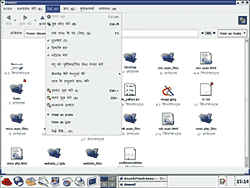 There are two main reasons for the digital divide: people can't 7afford computers or they don't have the English to use it.
There are two main reasons for the digital divide: people can't 7afford computers or they don't have the English to use it.
Nepal used to have the same problem. Now, with the development of open source software and Nepali unicode, there is at last a chance for users in Nepal to benefit from the IT revolution.
Microsoft's Windows2000 and XP are released in English, French, German, Spanish and other variants. The company's latest version of Office Suite is available in more than 20 languages. Although widely used, such software is out of reach for people in whose language it isn't released. Software giants don't benefit from localising their products so they don't do it. They keep away the underlying source code from alteration.
The way to get around this is through open source software which is widely available in different languages. Programmers can recompile source codes to reproduce the software in their own language. The popularity of open source software has appeal especially in developing countries. In China, India, South Korea, Brazil and other countries, governments are promoting the use of such software which, unlike the proprietary kind, allows users to inspect, modify and freely redistribute its underlying programming.
Adopting open source software is cheaper, they can be freely modified and are easier to translate or localise into indigenous languages. As an end product, for instance, the interface (menu, dialogue box, message strings and help file) will appear in Nepali and spread accessibility of computers who don't have English.
One of the arguments that the open source community uses against Microsoft is to question the security of Microsoft operating systems whereas many prefer Windows\' user friendliness over Linux\'s geekiness. Yet licensing and high price tag will push users to open source software which are usually free and can be localised.
KDE, one of the most popular graphic user interfaces or desktop interface for open source Linux, is available in more than 50 languages and 50 more are in the pipeline. Localised Nepali GNOME graphic user interface is also being developed and will be bundled with NepaLinux, expected to be released by the end of this year.  Localising software is a tedious job, requiring harmony between programmers and linguists. The project to localise the Nepali operating system, office suites, basic tools and utilities are already underway. Even though there are 92 different dialects in Nepal, localisation of software in Nepali for now would prove to be a milestone and open up avenues for computing in other Nepali languages. Nepali will therefore have both Windows and Linux in the near future, opening up a choice of operating systems for users.
Localising software is a tedious job, requiring harmony between programmers and linguists. The project to localise the Nepali operating system, office suites, basic tools and utilities are already underway. Even though there are 92 different dialects in Nepal, localisation of software in Nepali for now would prove to be a milestone and open up avenues for computing in other Nepali languages. Nepali will therefore have both Windows and Linux in the near future, opening up a choice of operating systems for users.
By releasing Unicode based Nepali keyboard input system for Windows, Linux and Macintosh, the Nepali Language Computing Project at Madan Puraskar Pustakalaya has at least made it possible to store and retrieve data fed in Devanagari characters. One can even query length of texts, name the files and customise limited menus and desktop labels in Devanagari.
That's not all, standardisation and development of unicode Nepali fonts has opened it up for localisation. Users will have the advantage of choosing a variety of softwares on different platforms according to one's need, scalability and purchasing capacity.
Presently, programmers are preparing to release their own versions of Nepali OS, office suite, email and Internet client package which will fulfil personal and office needs in Nepali. Yet, open-source software is more affordable and does not have propriety and licensing hassles.
The debate between open source software and proprietary software will go on. Microsoft products have an edge because of their user-friendliness whereas Linux requires an in-depth knowledge of customisation and there are few experts around who can fix bugs. Even Linux beginners don't dare run their machines exclusively on a single operating system fix bugs. The open source community needs to establish and groom a support network to spread the use of open source software.
Still, given the fact that users are developers and bugs are frequently self-corrected in open source softwares, they have started elbowing out proprietary software in many parts of the world where localisation is a priority, as it is here in Nepal. l
Vibek Raj Maurya is a freelance software developer with an interest in human technology interface.


